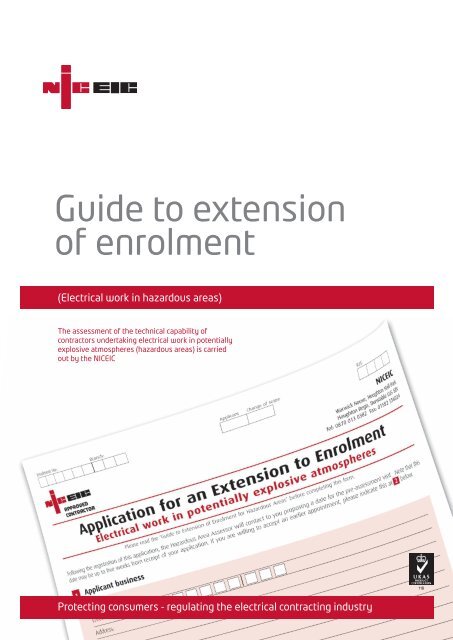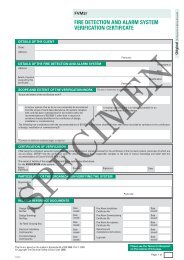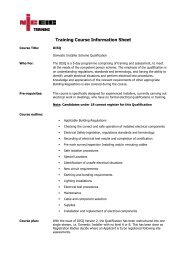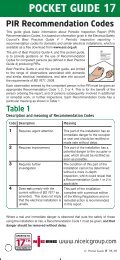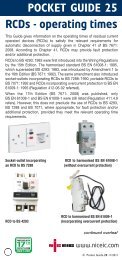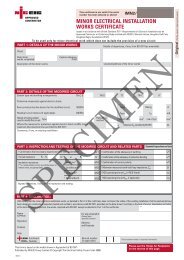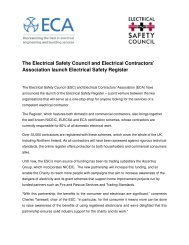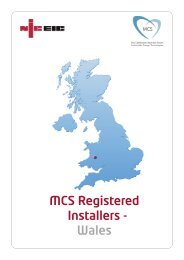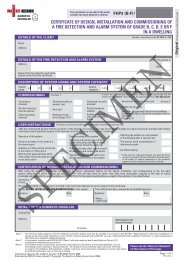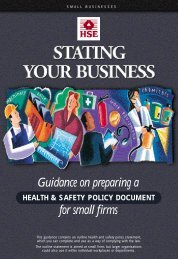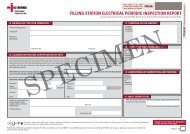NICEIC Hazardous Areas Guide
NICEIC Hazardous Areas Guide
NICEIC Hazardous Areas Guide
You also want an ePaper? Increase the reach of your titles
YUMPU automatically turns print PDFs into web optimized ePapers that Google loves.
Contents<strong>Guide</strong> to enrolment 3Benefits of extending the scope of enrolment 4Extending the scope of enrolmentrequirements 5Personnel 5• Principal Duty Holder• Qualified Supervisor (<strong>Hazardous</strong> <strong>Areas</strong>)• Training and supervision requirements• Persons responsible for inspecting and testing• Operatives• Training and experience recordsSteps to extending the scope of enrolment 9Completing the application form 10Completing the Qualified Supervisor(<strong>Hazardous</strong> <strong>Areas</strong>) Application form 14Assessment process 16• Preparation for Preliminary Application• Assessment visit• Preparation for on-site assessments• Assessment reports• Outcome of an application assessmentApplication process 21Extension to enrolment 21<strong>Guide</strong> to extension of enrolment2
<strong>Guide</strong> to enrolment<strong>NICEIC</strong> is an independent consumer safety body set up to protect users ofelectricity against the hazards of unsafe and unsound electrical installations.It is the electrical installation industry’s safety regulatory bodyThe <strong>NICEIC</strong> is not a trade association<strong>NICEIC</strong> approves contractors engaged in a broadrange of electrical installation work. All electrical workcarried out by Approved Contractors andConforming Bodies* is required to comply with therequirements of the national electrical installationsafety standard BS 7671 (IEE Wiring Regulations),and relevant Codes of Practice and guidancedocumentsElectrical work in potentially explosive atmospheres(hazardous areas) is not included within the standardscope of the accredited Approved Contractorcertification scheme, but an extension of <strong>NICEIC</strong>enrolment to cover such work may be gained througha separate application and assessment processPurpose of this guideThis <strong>Guide</strong> explains how <strong>NICEIC</strong> ApprovedContractors having UKAS-accredited enrolmentcertificates for electrical work in non-hazardousareas + can extend the scope of their enrolment toinclude electrical work in potentially explosiveatmospheres. Its aim is to assist ApprovedContractors applying for such an extension toEnrolment with <strong>NICEIC</strong>, but the <strong>Guide</strong> does not takeprecedence over the <strong>NICEIC</strong> Rules Relating toEnrolment<strong>NICEIC</strong>Electrical contractors throughout the UK<strong>NICEIC</strong> head office is in Dunstable.Electrical contractors are allocated to one ofthe <strong>NICEIC</strong>’s 75 local Area EngineersFor Approved Contractors undertaking electrical workin hazardous areas, the extension to the scope ofenrolment is expected to provide many benefits bothin terms of business development and technicalsupport*A Conforming Body is an organisation, such as a Local Government Authority, health trust or similar body, which undertakes electrical installation worksolely in connection with its own operation and not for others.Such organisations may apply for enrolment and will be assessed in a similar manner to acontractor+Exceptions may be made for Approved Contractors and applicants for enrolment that undertake electrical work in hazardous areas only<strong>Guide</strong> to extension of enrolment3
Benefits of extending the scope of enrolmentwith the <strong>NICEIC</strong>Business developmentIn addition to the benefits already enjoyed by allApproved Contractors, the extension to enrolmentwill provide:Technical supportOnly Approved Contractors having the hazardousarea extension have access to specialist technicalsupport via a dedicated technical helpline• An indication to clients, specifiers, licensingauthorities and others that a business isreputable, reliable and works to the industrystandards for electrical work in potentiallyexplosive atmospheres• Access to electrical installation work inhazardous areas from industrial, commercial andpublic sector organisations that will only employcontractors having recognised hazardous areacapabilities• An assurance to clients that electrical installationwork in hazardous areas is covered by the<strong>NICEIC</strong>’s Complaints Procedure and Guaranteeof Standards Scheme• Identification of recognised hazardous areacapability in the <strong>NICEIC</strong> Roll of ApprovedContractors, which is widely distributed andused by specifiers to select contractors toundertake electrical work<strong>Guide</strong> to extension of enrolment4
Extending the scope of enrolment requirementsThe extension to enrolment requirements cover the electrical contractingbusiness and its key personnelPersonnelA business applying for the extension to enrolment must have an appointed Principal Duty Holder, andpropose one or more Qualified Supervisors (<strong>Hazardous</strong> <strong>Areas</strong>) to take responsibility for the electrical workundertaken in potentially explosive atmospheres. In the case of a sole trader, the individual will be the PrincipalDuty Holder, who should propose himself as the Qualified Supervisor (<strong>Hazardous</strong> <strong>Areas</strong>).The businessTo be eligible for an extension to <strong>NICEIC</strong> enrolment for hazardous area work, a business must:✓✓✓✓✓✓be an <strong>NICEIC</strong> Approved Contractor having aUKAS accredited enrolment certificate forelectrical work in non-hazardous areas. Thisavoids the need to re-assess generalcompliance with the <strong>NICEIC</strong> Rules Relating toEnrolment, including competence toundertake electrical work in accordance withBS 7671, as part of the assessment forhazardous area work. (Exceptions may bemade for Approved Contractors andapplicants for enrolment that undertakeelectrical work in hazardous areas only)be directly engaged in electrical work inpotentially explosive atmospheres (other thanin mines, medical locations and locationsrelating to the manufacture and processing ofexplosives, and off-shore)have undertaken electrical work in potentiallyexplosive atmospheres for at least 6 monthsbe able to arrange access to a range of thathazardous area work sufficient for technicalevaluation and assessment purposeshave equipment appropriate to the range andscale of electrical work undertaken inhazardous areas (including, if appropriate,gauges such as feeler gauges)have test instruments suitable for carrying outthe range of tests required by BS 7671✓✓✓✓have at least two million pounds’ publicliability insurance cover for the full range ofelectrical work undertaken in potentiallyexplosive atmospheresmaintain a record of the accuracy andconsistency of test instruments used forcertification and reporting purposeshold British Standards and other technicalreference documents relevant to the rangeand scale of electrical work undertaken inpotentially explosive atmospheresmake available for inspection sufficientcompleted electrical work across the rangenormally undertaken in hazardous areas.The work must have been carried out duringthe previous twelve months under thebusiness’ current trading title. The workshould comply both with BS 7671 and withthe relevant British Standards, Codes ofPractice and guidance documents forhazardous area workWe’ve got it covered<strong>NICEIC</strong> Training Tel: 0870 013 0389<strong>NICEIC</strong> Direct Certificate, publications,DVDs, test equipment and more!Tel: 0870 013 0458<strong>NICEIC</strong> Insurance ServicesTel: 0870 601 2376<strong>Guide</strong> to extension of enrolment5
Extending the scope of enrolment requirements✓✓✓✓✓✓have a system in place to ensure thatappropriate prescribed forms of certificationand reporting are issued for all completedelectrical work in accordance with theappropriate technical reference documentsemploy persons competent to undertakeelectrical work in hazardous areas, who areadequately and appropriately supervisedestablish and maintain training and experiencerecords for each person who may be assignedto undertake electrical work in potentiallyexplosive atmospheres (except for personswho will be subject to constant supervision)maintain a record of complaints made aboutthe technical standard of electrical workcarried out, together with the details of theremedial action taken, if any, to resolve thecomplaintshave an appointed Principal Duty Holdernominate one or more suitable QualifiedSupervisors (<strong>Hazardous</strong> <strong>Areas</strong>) who meet theparticular requirements detailed in this <strong>Guide</strong>.A Principal Duty Holder may also benominated as a Qualified Supervisor(<strong>Hazardous</strong> <strong>Areas</strong>). The business must beable to demonstrate that all electrical workundertaken in hazardous areas will be underthe effective supervision of one or moreQualified Supervisors (<strong>Hazardous</strong> <strong>Areas</strong>)Requirements for a PrincipalDuty HolderThe Principal Duty Holder is the person appointedby the business who has responsibility for themaintenance of the overall standard and quality ofthe electrical installation work undertaken by thebusiness from a particular location.Principal Duty Holders are not subject toassessment by the <strong>NICEIC</strong>As for electrical work in non-hazardous areas,the appointed Principal Duty Holder must:• have responsibility for all matters relating toenrolment and be the focal point forcommunication with the <strong>NICEIC</strong>• be a principal or senior manager of the businesshaving an understanding of, and day to dayresponsibility for, the health and safety and otherlegal requirements relating to the range ofelectrical work undertaken by the business• be responsible for the assignment of electricalwork in hazardous areas to the QualifiedSupervisor(s) (<strong>Hazardous</strong> <strong>Areas</strong>)• be responsible for ensuring that there aresystems in place so that all work is carried out bycompetent persons who are adequetly andappropriately supervised• be responsible for the maintenance of adequatetraining and experience records for personsassigned to carry out electrical work inpotentially explosive atmospheres• ensure that there are systems in place wherebythe appropriate certificates and reports areissued for all completed electrical work.<strong>Guide</strong> to extension of enrolment6
Extending the scope of enrolment requirementsRequirements for a QualifiedSupervisorA Qualified Supervisor (<strong>Hazardous</strong> <strong>Areas</strong>) is anelectrically Competent person with specificresponsibility, on a day today basis, for the safety,technical standard and quality of electrical workunder his supervision in hazardous areasA Qualified Supervisor (<strong>Hazardous</strong> <strong>Areas</strong>)is responsible for:• ensuring that the results of inspection andtesting of electrical work in hazardous areas arerecorded correctly on the appropriate certificatesor reports• ensuring that the business’ premises,equipment, documentation and records areavailable for inspection when required• safeguarding all unused <strong>NICEIC</strong> certificates andreport forms for work in hazardous areas againstloss, theft and misuse.A proposed Qualified Supervisor(<strong>Hazardous</strong> <strong>Areas</strong>) must:• be a principal or employee of the applicantbusiness and be available on a full-time basis• comply with the normal requirements forQualified Supervisors (see Rule 5(3)) of the<strong>NICEIC</strong> Rules Relating to Enrolment• preferably be currently registered as a QualifiedSupervisor for the business’ electrical work innonhazardous areas. (Proposed QualifiedSupervisors (<strong>Hazardous</strong> <strong>Areas</strong>) who are notregistered as Qualified Supervisors for thebusiness will need to be separately assessed byan <strong>NICEIC</strong> Area Engineer for compliance withRule 5(3) of the Rules Relating to Enrolmentbefore the on-site evaluation of electrical work inhazardous areas can proceed. Suchassessment, normally taking a half-day, will besubject to an additional fee - see current feeschedule for details)• have at least two consecutive years’ supervisoryor managerial responsibility for the technicalstandard of electrical work in hazardous areas. Inthe case of a sole trader, evidence of carryingout hazardous area work over a two-year tradingperiod will satisfy this requirement if the requiredmanagerial or supervisory experience has notbeen gained elsewhere• satisfy the hazardous area training requirementsset out in Table 1. (The Assessor will require tosee the original assessment certificate for eachtraining course completed by the proposedQualified Supervisor (<strong>Hazardous</strong> <strong>Areas</strong>), asindicated on the application form, at thePreliminary Application Assessment visit).• be conversant with the Electricity at WorkRegulations, current edition of BS 7671, and theBritish Standards, Codes of Practice andguidance documents relevant to the range ofelectrical work undertaken in hazardous areas.Knowledge of hazardous area classification isalso needed• be fully versed in the inspection, testing,verification, certification and reportingprocedures for the range of electrical workundertaken in hazardous areas<strong>Guide</strong> to extension of enrolment7
Extending the scope of enrolment requirementsTable 1: <strong>Hazardous</strong> area training requirementsEither or both of the units may be chosenWith the introduction of the IECEx Certificate of Personal Competance the <strong>NICEIC</strong> will now accept this qualificationas an alternative to the CompEx qualifications previously required.Comp ‘Ex’ training unitsEX01 Preparation and installation of Ex ‘d’, ‘e’, ‘n’ and ‘p’ systemsEX02 Inspection and maintenance of Ex ‘d’, ‘e’, ‘n’ and ‘p’ systemsEX03 Preparation and installation of Ex ‘i’ systemsEX04 Inspection and maintenance of Ex ‘i' systemsEX05 Preparation and installation of apparatus protected by enclosure for use in the presence ofcombustible dustsEX06 Inspection and maintenance of apparatus protected by enclosure for use in the presence ofcombustible dustsEX07 Preparation, installation and de-commissioning of electrical installations at filling stationsEX08 Inspection, testing and maintenance of electrical installations at filling stationsEX09 Preparation and installation of electrical installations within the water industry(Ex ‘d’, Ex ‘e’, Ex ‘n’, Ex ‘p’, Ex ‘i’ and dust)EX10 Preparation and installation of electrical installations within the water industry(Ex ‘d’, Ex ‘e’, Ex ‘n’, Ex ‘p’, Ex ‘i’)‡<strong>NICEIC</strong> will accept satisfactory completion of EX01, EX02, EX03 and EX04 units as meeting the training requirementsfor electrical work on filling stations*<strong>NICEIC</strong> will accept satisfactory completion of the EX01, EX02, EX03 and EX04 units as meeting the trainingrequirements for electrical work at in the water industry.Note that satisfactory completion of the EX07 and EX08 units alone is unlikely to meet <strong>NICEIC</strong> trainingrequirements for electrical installations in other hazardous areas, due to the different explosion conceptslikely to be involved.Note that satisfactory completion of the EX09 and EX10 units alone is unlikely to meet <strong>NICEIC</strong> trainingrequirements for electrical installations in other hazardous areas, due to the different installationrequirements.IECEx CoPC unitsIECEx Unit 008 Performed detailed inspection of electrical installations in or associated with explosive atmospheres.Unit 008 requires either Unit 003 (Install explosion-protected equipment and wiring systems) or Unit 004 (Maintain equipment in explosiveatmospheres) as a pre-requisite.Note: The correct one of these units must be held for the type of work being carried out. e.g. holding Unit 004 wouldNOT cover the applicant for new installations.Scope LimitationsWhere Scope Limitations apply they must not exclude any area where work is being performed. The scope limitationmight exclude working on Ex p equipment (Pressurised). That is acceptable provided they do not work on EX p equipment.<strong>Guide</strong> to extension of enrolment8
Steps to extending the scope of enrolmentThe procedure for extending the scope of enrolment is straightforward.But please read this section carefullyOngoing training commitmentAll persons that may be engaged in electrical workin hazardous areas, other than persons subject toconstant supervision, will need to successfullycomplete the training units set out in Table 1, or theequivalent refresher training courses, as appropriateto the range of hazardous area work undertaken, atleast at five yearly intervals.Training and experience requirements forpersons responsible for inspecting and testingPersons other than Qualified Supervisors (<strong>Hazardous</strong> <strong>Areas</strong>)having responsibility for inspecting and testing electricalinstallations in hazardous areas are required to:• have successfully completed, within the past fiveyears, the training units set out in the Table asappropriate to the range of hazardous area workundertaken or• have successfully completed, within the past fiveyears, the equivalent refresher courses for the Comp’Exunits set out in the Table, as appropriate to the range ofhazardous area work undertaken or• provide evidence of equivalent training, together withevidence of experience of electrical installations inhazardous areas gained over at least three years. Personsaccepted under this option will be required tosuccessfully complete the training units set out in theTable, as appropriate to the range of hazardous areawork undertaken, within one year of acceptance.For the latter option, Approved Contractors would need todemonstrate that they have an effective system of training toensure that those persons undertaking inspection and testinghave:• an understanding of electrical standards and codes ofpractice relating to the selection, installation, maintenanceand use of explosion protected apparatus• a knowledge of methods used to maintain electrical integrityand explosion protection concepts• a knowledge of inspection procedures which may beemployed• a knowledge of any special electrical inspectiontechniques which may be required• understanding of drawings and manufacturer’s literaturerelevant to the equipment to be inspectedTraining and experience recordsApplicant businesses must be able to demonstrate,by means of documented training and experiencerecords, that all persons that may be engaged inwork in hazardous areas, other than personssubject to constant supervision, are competent toundertake the electrical work assigned to them.Such records will be subject to evaluation by theArea Engineer during both the application processand subsequent periodic assessment visits (toconfirm ongoing training).Training and supervision requirementsfor operativesAll operatives undertaking electrical installationwork in hazardous areas are required to:• have successfully completed, within the past fiveyears, the training units set out in the Table asappropriate to the range of hazardous area workundertaken or• have successfully completed, within the past fiveyears, refresher courses relating to the training units set outin the Table as appropriate to the range of hazardous areawork undertaken or• be kept under constant supervision by a Qualified Supervisor(<strong>Hazardous</strong> <strong>Areas</strong>) or another person who satisfies therequirements set out below for persons responsible forinspection and testing of electrical work in hazardous areas.'Constant supervision' means direct contact at the site of thework on at least a daily basis or• be kept under frequent supervision by a Qualified Supervisor(<strong>Hazardous</strong> <strong>Areas</strong>) or another person who satisfies the trainingrequirements set out above for those persons responsible forinspection and testing of electrical work in hazardous areas.'Frequent supervision' means direct contact at the site of thework on at least a weekly basis.For the latter option, Approved Contractors would need todemonstrate that they have an effective system of training toensure that those operatives undertaking electrical work inhazardous areas have an understanding of precautions (e.gmethod statement) to be taken to reduce the risk of explosions,and records confirming that the operatives have at least oneyear's experience of working in hazardous areas.<strong>Guide</strong> to extension of enrolment9
Completing the application formAn application for an extension to enrolment will beprocessed as soon as it is received by the <strong>NICEIC</strong>.The following items need to be provided by thebusiness to enable the application to proceed:• a completed 'Application for an Extension toEnrolment' form• a separate 'Qualified Supervisor (<strong>Hazardous</strong><strong>Areas</strong>) Application' form for each proposedQualified Supervisor (<strong>Hazardous</strong> <strong>Areas</strong>) forelectrical work in potentially explosiveatmospheres• copies (not the originals) of assessmentcertificates for the relevant training and orrefresher courses undertaken by the proposedQualified Supervisor(s) (<strong>Hazardous</strong> <strong>Areas</strong>)• a cheque covering the initial application fee*, asappropriateA separate application is required for eachcontracting office seeking to extend the scope ofenrolment to cover hazardous area work.On receipt of the completed application forms, copytraining certificates and the appropriate fee, the<strong>NICEIC</strong> will undertake the Preliminary ApplicationAssessment visit.*Application fees are not refundable. The initial application fee includesonly for the Preliminary Application Assessment visit to the contractingoffice. A further visit or visits will be required for the assessment of thetechnical standard of selected work completed, or in progress, inhazardous areas. A further fee will be payable for these on-siteassessment visits. The on-site assessment fee will be dependent on therange and location of the work to be assessed on site, as determined bythe Area Engineer. The Area Engineer will provide an estimate of the onsiteassessment fee during the Preliminary Application Assessment visit.The estimate will form the basis of a written quotation from the <strong>NICEIC</strong>.The application process for the extension to enrolment will proceed onacceptance of the quotation by the applicant business.10
Completing the application formSection 1: Applicant businessCompletion of this section should bestraightforward. The trading title given should beexactly the same as that registered with the <strong>NICEIC</strong>.If the applicant business is registered with the<strong>NICEIC</strong> as a Branch, the enrolment number shouldinclude the Branch numberA separate application is required for eachcontracting address seeking an extension toenrolmentSection 2: Appointment for the PreliminaryApplication AssessmentArea Engineers usually have full diaries for at leastfour weeks ahead. Therefore, allowing time toprocess the paperwork and to arrange anappointment, it may take up to five weeks to makethe initial visit to an applicant. However, AreaEngineers will try to arrange an earlier visit if theirdiaries permitPlease indicate whether or not you are willing toaccept an appointment with less than five weeks'notice by ticking the 'Yes' or 'No' box as appropriateSection 3: Public liability insuranceApplicants are required to have public liabilityinsurance of at least £2m which specifically coversthe business in respect of its electrical work inpotentially explosive atmospheres. The Area Engineerwill need to see evidence of this insurance coverduring the Preliminary Application Assessment visitto the contracting officeNote that it is evidence of public liability insurance,NOT employer's liability insurance, that the AreaEngineers will need to seeThe 'Yes' box should be ticked to confirm that theappropriate insurance cover is held, or will be held bythe time the Preliminary Application Assessment Visit<strong>Guide</strong> to extension of enrolment11
Completing the application formSection 6: Typical locations in which hazardousarea work is undertakenThis section enables an indication to be given of therange of locations in which the business hasundertaken hazardous area work. Read inconjunction with the information in Section 5, ithelps to ensure that an Area Engineer havingappropriate knowledge and experience isassigned to your applicationExamples of locations include filling stations, paintspraying equipment, fuel storage depots, gaspumping stations, oil refineries, flour mills, water andsewage treatment plantsSection 7: Electrical personnel involvedin hazardous area workIn this section, please indicate the number ofsupervisors (including proposed QualifiedSupervisors (<strong>Hazardous</strong> <strong>Areas</strong>), other operativesand trainees who are managed from the contractingoffice and are involved in hazardous area workThe Area Engineer will wish to evaluate the systemthe business has in place to ensure that allpersonnel assigned to hazardous area work arecompetent to undertake that work. For example,the Area Engineer will wish to examine the trainingand experience records for any person who hasworked in a hazardous area without constantsupervisionTick the box on the form to indicate that such asystem is in place, or will be in place before thePreliminary Application Assessment visit isundertakenSection 8: Technical reference documentsDepending on the range and scale of the hazardousarea work undertaken, the business will need tohold at least one copy of the latest edition of anumber of technical reference documents at itscontracting office. Additional copies maybe required, depending on the scale of thehazardous area work undertaken. The relevantreference documents to be held are as followsFor electrical work in hazardous areas wherethe risk is due to the presence of flammable gas,vapour, mist or dust:• BS EN 60079 Electrical equipment for explosiveatmospheresPart 10 - Classification of hazardous areasPart 14 - Electrical installations in hazardous areasPart 17 - Inspection & maintenance of electricalinstallations• EEMUA Practitioners Handbook(Publication No 186)For electrical work in the hazardous areas offilling stations:• IP/APEA Guidance for the design, construction,modification, maintenance and de-commissioningof filling stationsPossession of each of the relevant referencedocuments will be checked by the AreaEngineer during the Preliminary ApplicationAssessment visitTick the boxes on the form as appropriate toconfirm that the relevant reference documents areheld, or will be obtained before the PreliminaryApplication Assessment visitSection 9: DeclarationBefore signing the declaration, the Principal DutyHolder should read the text carefully as theapplication will effectively form an extension to thecontract that already exists between the ApprovedContractor and the <strong>NICEIC</strong><strong>Guide</strong> to extension of enrolment13
Completing the Qualified Supervisor(<strong>Hazardous</strong> <strong>Areas</strong>) application formA separate application form is required for eachproposed Qualified Supervisor (<strong>Hazardous</strong> <strong>Areas</strong>).The requirements,including those relating to trainingand experience, are given earlier in this <strong>Guide</strong>Section 1: BusinessCompletion of this section should be straightforward.The trading title given should be exactly the same asthat registered with the <strong>NICEIC</strong>Section 2: Details of proposed QualifiedSupervisor (<strong>Hazardous</strong> <strong>Areas</strong>)The completion of this section should also bestraightforward. Provision of the National InsuranceNumber enables the person's details to be recordedin the <strong>NICEIC</strong> register of Qualified SupervisorsSection 3: Supervisory or managerialresponsibility for hazardous area workPersons proposed as Qualified Supervisors(<strong>Hazardous</strong> <strong>Areas</strong>) are required to have had at leasttwo years' supervisory or managerial responsibility forthe standard of electrical work in hazardous areas.Confirmation of this can be given by ticking the 'Yes'box. Assessors may require to see evidence of suchprevious responsibilityIf a nominated person is not already registeredwith the <strong>NICEIC</strong> as a Qualified Supervisor forelectrical work in non-hazardous areas, theperson will need to be assessed against therequirements of Rule 5(3) of the <strong>NICEIC</strong> RulesRelating to Enrolment before the on-siteevaluation of electrical work in hazardous areascan proceedSuch assessment will be subject to an additional fee,normally for a half-day visit. (See the fee schedule).Separate application forms for proposed QualifiedSupervisors are available on request from the <strong>NICEIC</strong>Operations Administration DepartmentSection 4: <strong>Hazardous</strong> area experienceThe proposed Qualified Supervisor (<strong>Hazardous</strong><strong>Areas</strong>) should indicate the range of hazardous areawork carried out personally on a regular basisThe proposed Qualified Supervisor (<strong>Hazardous</strong><strong>Areas</strong>) should also indicate whether or not he/shehas had at least two years' practical experience ofthe application of each of the zonal and protectionconcepts applicable to hazardous area workPersons proposed as Qualified Supervisors(<strong>Hazardous</strong> <strong>Areas</strong>) are also required to be a principalor employee of the applicant business available on afull time basis. Confirmation of this can be given byticking the 'Yes' boxPreferably, persons nominated as QualifiedSupervisors (<strong>Hazardous</strong> <strong>Areas</strong>) should currently beregistered with the <strong>NICEIC</strong> as Qualified Supervisorsfor electrical work in non-hazardous areas<strong>Guide</strong> to extension of enrolment14
Completing the application formSection 5: Training undertakenThe proposed Qualified Supervisor (<strong>Hazardous</strong><strong>Areas</strong>) should indicate which Comp'Ex' Units havebeen satisfactorily completed, giving the year inwhich the assessment certificate was awarded.A copy (NOT the original) of the assessmentcertificate for each training unit completed shouldbe attached to the application formDetails of any Comp'Ex' refresher courses attendedshould also be given, and copy assessmentcertificates attachedDetails of any other relevant technical trainingcourses attended should be given in the spaceprovidedDuring the Preliminary Application Assessmentvisit, the Area Engineer will require to see theoriginal certificate for each training courseundertakenSection 6: DeclarationsThe proposed Qualified Supervisor (<strong>Hazardous</strong><strong>Areas</strong>) should sign the declaration in the spaceprovided to confirm that the details provided on theform are correct and that he fully understands therequirements for Qualified Supervisors (<strong>Hazardous</strong><strong>Areas</strong>)The Principal Duty Holder should then also sign theform to confirm on behalf of the business that theproposed Qualified Supervisor (<strong>Hazardous</strong> <strong>Areas</strong>) isconsidered to be competent within the meaning ofthe Electricity at Work Regulations 1989<strong>Guide</strong> to extension of enrolment15
Assessment processEnquiry to <strong>NICEIC</strong>Information dispatched or downloaded from Web siteContractor returns completed application with fee<strong>NICEIC</strong> records application details and forwards the information to the Area Engineer<strong>Areas</strong> Engineer contacts contractor and arranges preliminary application visit. During thevisit the contractor is informed of any actions to be taken prior to on-site assessment.Contractor is provided with an estimate of on-site assessmentQuote prepared and sent to contractorContractor accepts the quotation for assessment on-siteContractor prepared for on-site assessmentOn-site assessment visit(s) carried out by Area Engineer<strong>Areas</strong> Engineer completes Assessment Report indicatingany observed non-compliances and the recommendationconcerning enrolmentFurther assessment visit undertakenArea Engineer gives report to contractor and sends copyto <strong>NICEIC</strong> Head Office for enrolment decisionEnrolment decision by <strong>NICEIC</strong> Head OfficeContractors provided withconfirmation of non-compliancesobserved during assessment visit(s)Documentary evidenceprovided by all contractorsto confirm all major noncompliancessatisfactorilyaddressed*Application held pending completionof actions to achieve complianceContractor advises <strong>NICEIC</strong>Head Office that actions have beencompletedAnnualEnrolmentContractor informed that the requirements for the extensionto enrolment have been metPeriodic assessments carried out to confirm continuedcompliance with <strong>NICEIC</strong> Rules*Note. Any major non-compliance relating to the technical standard of work or the responsibilities of theQualified Supervisor (<strong>Hazardous</strong> <strong>Areas</strong>) would necessitate a further assessment visit.<strong>Guide</strong> to extension of enrolment16
Assessment processVisits by Area Engineers are programmed into theirschedule of work, and appointments will normally bemade up to five weeks in advance of a visit. However,it may be possible to arrange for an earlier visit if theArea Engineer's diary permitsA Preliminary Application Assessment visit, whichusually lasts a half-day, provides ample opportunity toconfirm the range of electrical work being undertakenin hazardous areas, to discuss the assessmentprocess and criteria in detail, and to answer anyquestions arising. The Area Engineer, subject tothe time available, will also assess the extent to whichthe business and proposed Qualified Supervisor(<strong>Hazardous</strong> <strong>Areas</strong>) satisfy the particular requirementsrelating to the proposed extension to enrolmentExperience has shown that generally, PreliminaryApplication Assessment visits tend to minimise thecost and timescale of the application process, asapplicants are generally better prepared forassessmentThe assessment process for the extension toenrolment will focus on the special requirementsrelating to electrical work in potentially explosiveatmospheres. It will generally not cover mattersrelating to the basic electrical safety requirements ofBS 7671, as the business' compliance with the<strong>NICEIC</strong> Rules for electrical work in non-hazardousareas will have already been assessed under thenormal <strong>NICEIC</strong> assessment processThe assessment process is carried out in twophases. In the first phase, the Preliminary ApplicationAssessment Visit will be used to assess compliancewith all the requirements relating to hazardous areawork which do not require a site visit. In the secondphase, a representative sample of the range ofhazardous area work undertaken by the business willbe evaluated on site by means of on-siteassessmentsIf the information provided with the application iscomplete and indicates general compliance with therequirements for the extension to enrolment, theapplication forms will be forwarded to the local<strong>NICEIC</strong> Area Engineer who will arrange to carry out aPreliminary Application Assessment visit as soonas possiblePreliminary Application Assessment VisitA Preliminary Application Assessment visit normallylasts half day. It will be conducted at the business'contracting officeTo get maximum value from a PreliminaryApplication Assessment visit, both the PrincipalDuty Holder and the proposed QualifiedSupervisor(s) (<strong>Hazardous</strong> <strong>Areas</strong>) must be presentto discuss the application with the Area EngineerDuring a Preliminary Application Assessment visit, theArea Engineer will review the extent to which thebusiness and key personnel satisfy the requirementsfor the extension to enrolment and will:• explain the assessment criteria and process• explain the role of the Qualified Supervisor(<strong>Hazardous</strong> <strong>Areas</strong>)• review and confirm the range of hazardous areawork undertaken by the business over the past 12months, which will form the scope of the extensionto enrolment• identify the range of work which will need to beevaluated on site, review the nature and locationsof the possible sites to be visited, and discuss theaccessibility of the work on those sites• discuss the programme and likely costs of theassessment process• review the training and experience of the proposedQualified Supervisor(s) (<strong>Hazardous</strong> <strong>Areas</strong>)• review the system the business has in place toensure the competence of all other persons thatmay be assigned to undertake electrical work inhazardous areas without constant supervision• discuss the requirement to provide appropriatestandard certificates and reports to clients, and togive guidance where necessary on theircompletion• identify any significant likely non-compliances withthe requirements for the extension to enrolmentwhich the business will need to address prior to theassessment visit• provide any other general information and adviceon the requirements for the extension to enrolment<strong>Guide</strong> to extension of enrolment17
Assessment processThe Area Engineer, subject to the time available,will then:• explain the assessment process and confirm theroles of the Principal Duty Holder and the QualifiedSupervisor (<strong>Hazardous</strong> <strong>Areas</strong>)• discuss and confirm the range of hazardous areawork undertaken by the business• review the details of all the business' hazardousarea work completed within the previous year andin progress• draw up a plan for the on-site evaluation of thetechnical standard of a representative sample ofthe business' hazardous area work, taking intoaccount the location of the sites to be visited andany known access restrictions. (The proposedQualified Supervisor(s) (<strong>Hazardous</strong> <strong>Areas</strong>)responsible for the work to be evaluated will berequired to be present throughout the on-siteassessments)• check possession of the relevant technicalreference documents for the range and scale ofhazardous area work undertaken• check that appropriate certificates and reportshave been issued to clients• check the hazardous area training and experienceof the proposed Qualified Supervisor (<strong>Hazardous</strong><strong>Areas</strong>)• identify any significant non-compliances with thegeneral requirements of the <strong>NICEIC</strong> Rules and theparticular requirements for hazardous areas whichthe business will need to address, in some casesprior to the on-site assessment visits• check possession of adequate number of testinstruments and test leads appropriate to therange and scale of electrical work undertaken• check records demonstrating that a system is inplace to ensure the accuracy and consistency oftest instruments used for certification and reportingpurposes• provide an estimate of fees for undertaking the onsiteassessments, based on the standard feeschedule. (This estimate will form the basis of aformal quotation from the <strong>NICEIC</strong> for thecompletion of the application process)At the end of the Preliminary Application Assessmentvisit, the Area Engineer will issue a checklist of thevisit and a report identifying any non-compliancesobserved which require further action to be taken onsiteassessment visit takes placeNote: when the on-site assessment visit(s) are carriedout at a protracted period after the PreliminaryApplication Assessment visit, some items may needto be shown to the Area Engineer again• check the training and experience records ofpersonnel assigned to hazardous area work• check the business' record of any complaintsmade by customers about the technical standardof the business'work in hazardous areas, togetherwith the details of the remedial action taken toresolve them. (The record may be part of thecomplaints register maintained for the business'electrical work in non-hazardous areas)• check that risk assessments appropriate toundertaking electrical installation work inhazardous areas are available<strong>Guide</strong> to extension of enrolment18
Preparation for assessment visitPreparation for assessment visitTo enable the business to gain most benefit from thevisit, and to enable the assessment process to besuccessfully completed as quickly as reasonablypossible, it is important that each of the itemsshown are made ready for examination andassessment, prior to the Area Engineer's arrivalPlant and equipmentThe Area Engineer will need to establish that thebusiness has plant, tools and materials appropriateto the range and scale of the electrical workundertaken in hazardous areas.Technical reference documentsThe Area Engineer will need to check that, as aminimum, the business holds the latest edition ofeach of the following technical reference documentsat its place of business:For electrical work in hazardous areas wherethe risk is due to the presence of flammablegas or vapour:• BS EN 60079 Electrical equipment for explosivegas, vapour, mist or dustPart 10 - Classification of hazardous areasPart 14 - Electrical installations in hazardous areasPart 17 - Inspection and maintenance of electricalinstallations• EEMUA Practitioners Handbook(Publication No 186)For electrical work in the hazardous areas offilling stations:• IP/APEA Guidance for the design, construction,modification and maintenance and decommissioningof filling stationsInstallation certificates and reports issuedto clientsBS 7671: requires that an Electrical InstallationCertificate, together with a schedule of inspectionsand a schedule of test results, is issued to theperson ordering the work following the initialverification of an electrical installation. Alternatively,where appropriate, a Minor Electrical InstallationWorks Certificate may be issuedBS 7671: also requires that a Periodic InspectionReport, together with a schedule of inspections anda schedule of test results, is issued to the personordering the work following the periodic inspectionof an electrical installationThese electrical certificates and reports should beaccompanied by the appropriate hazardous areaforms, as detailed in BS EN 60079-17 or theIP/APEA <strong>Guide</strong>.The Area Engineer will review a sample ofcertificates, reports and schedules issued during theprevious year, including records of the results ofinitial and periodic inspections of installationsTraining certificates - proposed QualifiedSupervisor (<strong>Hazardous</strong> <strong>Areas</strong>)The Area Engineer will need to check the originals ofthe hazardous training certificates of the proposedQualified Supervisor (<strong>Hazardous</strong> <strong>Areas</strong>)Competence of operativesThe Area Engineer will need to check the system(such as training and experience records) that thebusiness uses to ensure that all operativesemployed on electrical work in potentially explosiveareas are either competent to undertake the work,or are placed under the supervision of a competentperson whilst undertaking such work. 'Constantsupervision' means direct contact at the site of thework on at least a daily basisPublic liability insuranceEvidence of a minimum of two million pounds' covermust be provided to the Area Engineer for the rangeof work undertaken by the business in hazardousareas. Note that it is public liability insurance, notemployers' liability insurance, that needs to becheckedList of electrical workA detailed list of all hazardous area work completedby the business during the previous year, and of allwork in progress, must be made available to enablethe Area Engineer to select the samples of work tobe assessed on site at a later date<strong>Guide</strong> to extension of enrolment19
Preparation for assessment visitThe Area Engineer will select a suitable number ofsamples across the range of electrical work carriedout to evaluate during the on-site assessmentsList of complaints about the technical standardof the business' workA record of all complaints made by customersabout the technical standard of the contractor'swork in hazardous areas, together with the details ofthe remedial action taken to resolve them, must beavailable for the Area Engineer to examinePreparation for the on-site assessment visit(s)The number and duration of on-site assessmentvisits allowed for in the plan produced by theassessor during the Preliminary ApplicationAssessment, as far as possible, take account of therange of hazardous area work to be evaluated, thelocation of the sites to be visited, and any knownrestrictions on access to those sitesThe proposed Qualified Supervisor (<strong>Hazardous</strong><strong>Areas</strong>) responsible for the work to be evaluatedmust be present throughout each on-siteassessmentAccess arrangementsThe proposed Qualified Supervisor (<strong>Hazardous</strong><strong>Areas</strong>) will be expected to make adequatearrangements for access to the electrical work ateach of the sites or premises selected, and tomeet the Area Engineer at each of those places.Suitable plant (hand tools etc) for this purpose arerequired to be provided by the applicant business.The Principal Duty Holder need not be presentduring on-site assessment visitsWhere access restrictions prevent the completion ofthe assessment plan within the period of timeallocated, a further visit or visits may be necessaryto complete the assessment of the contractor'scompliance with the Rules. A fee is payable for anysuch additional visits madeCompetence of the proposed QualifiedSupervisor (<strong>Hazardous</strong> <strong>Areas</strong>)During the on-site assessments, the Area Engineerwill expect the proposed Qualified Supervisor(<strong>Hazardous</strong> <strong>Areas</strong>) to demonstrate an in-depthappreciation of the requirements of the BritishStandards and Codes of Practice relevant to therange of hazardous area work undertaken by thebusinessSpecific demonstration of compliance with therequirements of BS 7671 will not normally berequiredThe proposed Qualified Supervisor (<strong>Hazardous</strong><strong>Areas</strong>) must take to site the records of the initialinspection and/or periodic inspection of theinstallations selected for evaluationThese electrical certificates and reports should beaccompanied by the appropriate hazardous areaforms, as detailed in BS EN 60079 - 17 or theIP/APEA <strong>Guide</strong>The proposed Qualified Supervisor (<strong>Hazardous</strong><strong>Areas</strong>) will normally be expected to carry out a closeinspection* of parts of electrical installationsselected by the Area Engineer, to demonstratecompliance with the relevant standards. Wherecircumstances permit, a detailed inspection* maybe requiredIf the proposed Qualified Supervisor (<strong>Hazardous</strong><strong>Areas</strong>) is not fully conversant with the requirementsof the relevant standards for the range of hazardousarea work undertaken, he/she may need toundertake further training, and be re-assessed,before an extension to enrolment can be grantedAssessment reportsThe Assessor will issue an Assessment Report atthe end of each assessment visit. The report willindicate the level of the business' compliance withthe Rules. Any observed non compliances with the<strong>NICEIC</strong> Rules will be recorded for action by thebusiness*'Close inspection' and 'detailed inspection' are defined inBS EN 60079-17<strong>Guide</strong> to extension of enrolment20
Extension to enrolmentOutcome of an application assessmentA completed application assessment will result inthe Area Engineer making one of the followingrecommendations to <strong>NICEIC</strong> Head Office:Extension to be grantedAn extension of enrolment will be recommended bythe Area Engineer if the business is compliant withthe Rules. The scope of the extension will bedetailed in a schedule forming part of the 'Extensionto Enrolment' certificateA periodic assessment plan will need to beestablished by the Area Engineer, based on therange, scale and geographical spread of thehazardous area work undertaken. Periodicassessments are carried out in a similar manner tothe application assessment visits, usually involving avisit to the contracting office and an appropriatenumber of on-site assessment visitsApplication to be deferredIf the business does not currently satisfy the <strong>NICEIC</strong>Rules, but is likely to do so after it has addressedthe noncompliances identified in the AssessmentReports, the Area Engineer will recommend thatfurther consideration of the application is deferredShould the business wish to continue with itsapplication after addressing the non-compliances,one or more further assessment visits will normallybe necessary, for which an additional charge ismade. (Exceptionally, a further assessment visitwould not be required if the business canprovide appropriate documentary evidence toconfirm that all non-compliances have beensatisfactorily addressed).However, any non-compliance relating to thetechnical standard of electrical work or theresponsibilities of the Qualified Supervisor(<strong>Hazardous</strong> <strong>Areas</strong>) would necessitate afurther assessment visit)If a further assessment visit or visits are considerednecessary, the Area Engineer will give an indicationof the extent of re-assessment requiredApplication to be rejectedThis is recommended if the Area Engineer considersthat the business will be unable to comply with the<strong>NICEIC</strong> Rules in respect to hazardous area work. Ifthe business is eligible to re-apply for an extension toenrolment, a fresh application may be considered,usually after a period of six months has elapsedThe final stageThe decision on the outcome of an applicationassessment rests with <strong>NICEIC</strong> Head Office. Thebusiness will be informed of the decision in writingas soon as possible. The business may appealagainst the decision if it is considered to be unfairExtension to enrolmentOnce the enrolment process has been satisfactorilycompleted, an <strong>NICEIC</strong> Extension to EnrolmentCertificate will be issued and the business can bepromoted as having been assessed by the <strong>NICEIC</strong>for electrical work in the hazardous areas coveredby the scope of the certificate. The extension toenrolment will be published in all forms of the<strong>NICEIC</strong> Roll of Approved Contractors andConforming Bodies, which is used by specifiersand the public to select competent electricalcontractorsSubject to certain conditions, the business will beeligible to display the distinctive <strong>NICEIC</strong> Registrationand Certification Marks, and purchase the <strong>NICEIC</strong>certificate and report forms appropriate to the rangeof hazardous area work within the scope of itsextension to enrolment<strong>Guide</strong> to extension of enrolment21
Extension to enrolmentPeriodic AssessmentA periodic assessment plan will need to beestablished, based on the range, scale andgeographical spread of the hazardous area workundertaken. Periodic assessments are carried out ina similar manner to the application assessmentvisits, usually involving a visit to the contractingoffice and a number of on-site assessment visitsIf, on successive occasions, a type of hazardousarea work included within the scope of an Approvedcontractor's extension to enrolment is not availablefor assessment by the Council, the Council may atits discretion withdraw approval for that type of workTraining and experience records will be subject toevaluation during each periodic assessment cycleAs a guide, the minimum time required for a periodicassessment is likely to be similar to the time requiredfor the initial application assessment (excluding anyrevisits to confirm corrective action)An assessment report will be issued at the end ofeach periodic assessment visitIf a visit reveals non-compliances with the <strong>NICEIC</strong>Rules, including the particular requirements forhazardous areas, the business will be required totake appropriate action to rectify them. If the noncompliancesare significant, this may involve theArea Engineer making a further visit within threemonths to confirm that the necessary level ofcompliance has been achieved, An additionalcharge will be made for such re-assessment visitsIf the range, scale or geographical spread of anApproved Contractor's electrical work changes overthe course of time allocated for periodicassessments will be changed to suitApproved Contractors are not precluded fromundertaking any type of electrical work within theircompetenceHowever, a business must not imply that it isapproved by the Council when offering to carryout hazardous area work beyond the scope setout in its 'Extension to Enrolment' certificate.If a business continues to undertake types ofhazardous area work beyond the scope of it'Extension to Enrolment' certificate, the businessmust apply to extend the scope of its extension toenrolment at the earliest opportunity<strong>Guide</strong> to extension of enrolment22
Further InformationFurther information on the enrolment process is available by writing to:Operations Administration Manager<strong>NICEIC</strong>Warwick HouseHoughton Hall ParkHoughton RegisDunstable LU5 5ZXTel: 01582 531000Fax: 01582 531010Website: www.niceic.comStandard documents:Application for Extension to Enrolment formQualified Supervisor (<strong>Hazardous</strong> <strong>Areas</strong>)Application formCompEx LiteratureHA G May 2012


